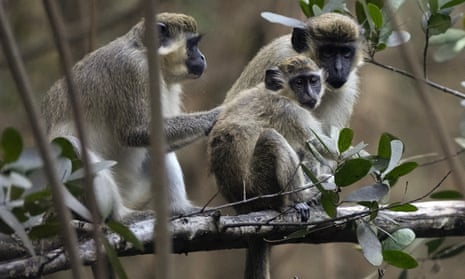The government of Sint Maarten in the eastern Caribbean has approved a controversial plan to cull its entire population of vervet monkeys, as the proliferation of the invasive species becomes an increasing nuisance on the Dutch island territory.
Authorities will fund the Nature Foundation St Maarten NGO to capture and euthanise at least 450 monkeys over the next three years in the territory which borders French St Martin.
“When a species establishes a population in an area that it isn’t native to there are often no predators to keep the population size under control,” said the foundation’s manager, Leslie Hickerson. “Species management is an important aspect of keeping the island healthy for those who come after us.”
But not everyone agrees, with critics of the plan arguing that sterilisation and environment management should instead be considered.
Vervet monkeys, characterised by their dappled grey brown bodies and black faces fringed with white fur, are native to southern and eastern Africa but can also be found in some Caribbean islands such as St Kitts and Nevis, where the population has grown to the tens of thousands.
The monkeys were introduced to the region sometime around the 17th century when European settlers were thought to have brought them over as exotic pets.
Research carried out by the Nature Foundation St Maarten found in 2020 that about 450 vervet monkeys were living on the Dutch side of the island.
An updated survey has not yet been completed, but according to a foundation press release, initial numbers indicate a large increase in troop size.
“The number of monkeys in Sint Maarten will continue to grow if no measures are taken, and the consequences to Sint Maarten’s native ecosystems will be severe,” it said.
Farmers have complained of vervet monkeys “raiding their crops and destroying their livelihood”, the foundation said.
But Dave Du Toit, founder of the Vervet Monkey Foundation in South Africa, where the species is native, said the cull was unlikely to work.
“I think a better approach and more publicly acceptable would be to vasectomise the males and sterilise the females,” he said.
The non-profit, which shelters orphaned and injured primates, also educates the public on the role of vervet monkeys in the ecosystem and how to prevent human-monkey conflict.
Du Toit said that to allow for a more harmonious existence between the monkeys and Sint Maarten residents, research into the availability of food for wildlife needs urgent attention.
“Where, how and what food sources are disposed of that attract the monkeys needs to be addressed [and] what natural areas can be utilised by wildlife without interference,” he said.
The Nature Foundation St Maarten set up its invasive species project in 2020 to study the vervet monkey population and develop a management plan. This was approved in June 2022, allowing it to hire a terrestrial ranger to capture the vervet monkeys.
In December, the territory’s ministry of tourism, economic affairs, transportation and telecommunication approved 100,000NAf ($55,000) funding per year for the project.
“The foundation proposed two management options when requesting funding for these activities, one of which was a sterilisation programme and one which was a population management programme,” Hickerson said.
“The funding received to execute the project was the minimum requested in order to start managing the population.”
Eusebio Richardson, a ranger with the foundation, said the government funding is “essential” for the project’s success and has been used to purchase materials, equipment and training.
“We were able to learn from an established trapper in St Kitts the most effective management practices,” Richardson said.
“This is key to ensure that within the time allowed we can make an impact and protect the biodiversity of the island.”
Hickerson said that because of how quickly they reproduce it “would be best” to capture or relocate the entire island’s monkey population.
The foundation plans to meet with the relevant agencies from French St Martin this week to discuss their part in the project.
The Réserve Naturelle Nationale de Saint-Martin said in 2021 that the introduction of non-native animals such as vervet monkeys was eroding its natural heritage.
